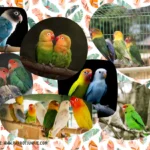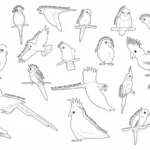
Cockatiels – An Overview of Characteristics and Care
Cockatiels, with their charming personalities and colorful crests, have captured the hearts of bird enthusiasts around the world. These small parrots are native to Australia and are the second most popular pet birds globally, coming in just behind budgerigars (also known as budgies or parakeets).
The popularity of cockatiels isn’t surprising given their friendly and affectionate nature. They can form close bonds with their human caretakers, display fascinating behaviors, and are known for their delightful vocalizations. Some can even mimic common household sounds or a favorite tune, providing much entertainment for their owners.
In this overview, we’ll delve into the characteristics of cockatiels, covering aspects like their physical attributes, dietary requirements, environmental needs, and more. Whether you’re a prospective cockatiel owner or just a curious bird enthusiast, this guide will offer you a comprehensive understanding of these captivating birds.
Jump To Section
Where Cockatiels Live In Nature
The cockatiel (Nymphicus hollandicus) has its roots in the land Down Under—Australia. In the wild, these birds are found across the continent, inhabiting both open country and wetlands, but always in proximity to a water source. They thrive in a variety of habitats, including bushlands, woodlands, and even areas modified by humans like farmland and suburban parks. Cockatiels in their natural habitat lead a nomadic lifestyle during non-breeding seasons, moving in large flocks in response to the availability of water and food. Their diet in the wild mainly consists of seeds and grains, but they also consume a variety of fruits, vegetables, and sometimes insects.
Physical Characteristics of Cockatiels
Cockatiels are considered small, usually ranging from 11-13 inches in length (28-33cm) from head to tail. Their weight typically falls between 75 to 125 grams.
One of the cockatiel’s most striking physical attributes is its distinctive crest. This set of elongated feathers on the top of their head can be raised or lowered to communicate various emotions or responses. When the crest is raised straight up, the bird could be startled or very curious. Conversely, a relaxed or flat crest may indicate a calm or content bird.
Cockatiels are known for their variety of color mutations, including grey, lutino (yellow or white with red eyes), cinnamon, pearl, and whiteface, among others. The wild-type, or most common coloration, is primarily grey with white on the wings, a yellow face, and a bright orange cheek patch.
Sexual dimorphism (differences in appearance between males and females), is evident in cockatiels, although not as pronounced as in some bird species. Male cockatiels are typically more brightly colored and have a larger, more vivid cheek patch than females. Females often have barred markings on the underside of their tail feathers, which males lack after their first molt.
Cockatiel Behavior and Personality
Cockatiels are renowned for their sociable and affectionate demeanor, making them wonderful companions for those who can provide ample interaction. They are also known for their intelligence and can learn to understand and respond to basic commands.
Cockatiels are very expressive birds, often using their crest to communicate their feelings. A straight-up crest may indicate alertness, surprise, or curiosity, while a flat crest often signifies a relaxed and content bird. Paying attention to these subtle cues can help owners understand and respond to their pet’s needs effectively.
Cockatiels are also known for their vocalizations, although they are typically not as loud as some larger parrot species. Males are especially vocal and are more likely to learn tunes and mimic sounds compared to females. Their “songs” often consist of whistles, chirps, and mimicked noises. Some cockatiels can even mimic human speech, although their ability to do so is usually limited compared to species like African Greys or Amazons. This is often a reason for people wanting to buy a bird, but it is important to be aware that not all birds can be trained to talk.
Despite their generally friendly nature, cockatiels, like all birds, may exhibit signs of stress or discomfort through behaviors like feather plucking, loss of appetite, or excessive squawking. These signs should never be ignored, as they could indicate a health issue or an inadequate environment.
In addition to their need for social interaction, cockatiels also require mental stimulation. Providing toys and opportunities for play can help meet this need, as can training sessions where the bird can learn new tricks or commands. Regular out-of-cage time in a safe and bird-proof area is also vital for their well-being.
Cockatiels’ Dietary Requirements
Cockatiels, like all creatures, have specific dietary needs that must be met for them to maintain good health. Their diet plays a crucial role in their lifespan, energy levels, feather health, and overall well-being.
The foundation of a cockatiel’s diet should be a high-quality, commercially prepared pellet specifically designed (size-wise) for cockatiels or small parrots. Pellets often contain multiple essential nutrients for birds, ensuring your cockatiel receives the right blend of vitamins, minerals, and other necessary nutrients.
In addition to pellets, fresh fruits and vegetables should form a substantial part of their diet. These provide essential vitamins and nutrients that may not be adequately supplied by pellets alone. Examples of safe fruits and vegetables include apples (without seeds), bananas, carrots, peas, corn, and leafy greens like kale and spinach. It is also important to know what specific food items are toxic or unhealthy to birds and should be avoided.
Seed mixes can also be provided, but they should be limited as they are high in fat and not nutritionally balanced. Many cockatiels will selectively eat their favorite seeds, typically the fattiest ones, and leave the rest, leading to an imbalanced diet.
Fresh water should always be available for your cockatiel, and it should be changed daily, or more often if it becomes dirty.
Housing and Environmental Needs
Creating an appropriate and stimulating environment is crucial for your cockatiel’s health and happiness. Below are some key considerations for housing and environment setup.
Cage Size and Setup
Cockatiels require a spacious cage that allows them to stretch their wings, move about freely, and exercise. A recommended cage size for a single cockatiel is at least 24 by 24 by 24 inches (~60cm). Even though cockatiels are considered small parrots, they need a larger cage space as compared to other small parrots like lovebirds and budgies, to cater enough space for their long tails. If space allows, bigger is always better, but bear in mind that cage bar spacings should not be bigger than 1/2″ to 5/8″ (~1.2-1.6cm) as their heads might get stuck between wider cage bars.
Place several perches of different diameters and textures inside the cage to promote foot health. Avoid placing perches directly above food and water dishes to prevent them from being dirtied.
Cleanliness is crucial to prevent diseases. Regularly clean the cage, perches, and toys with bird-safe disinfectants. Food and water dishes should be cleaned daily.
Toys and Mental Stimulation
Cockatiels are intelligent birds and require toys and activities to keep their minds active. Ensure a variety of toys are available, including chew toys, foraging toys, swings and ladders. Rotate toys regularly to keep the environment stimulating.
Be sure all toys are safe and free from small parts that could be ingested, and cotton rope and fibers or long strings that could entangle the bird.
Light and Temperature
Cockatiels, like all birds, need a regular light-dark cycle to thrive. Place the cage in a well-lit area during the day, and provide a darker environment each night for sleep. Avoid placing the cage in direct sunlight for too long.
Amongst bird species, cockatiels are anecdotally known to have “night frights” where unusual sounds or shadows at night cause them to be spooked out. To mitigate this, owners often place a small night lamp near the cage that is not too bright, but allows the cockatiel to be able to observe their environment well.
It is best to keep their cages covered with a lightweight, dark cloth, to enable them to feel more at ease while sleeping at night.
While typical reported ideal temperatures for cockatiels is between 65 and 80 degrees Fahrenheit (18-26 degrees Celsius), the general rule of thumb is to avoid sudden, drastic changes in temperatures, or to leave them in excessively warm or cold conditions for long periods of time.
Environmental Safety
Cockatiels need daily out-of-cage time for exercise and socialization. This requires a safe, bird-proof space where they can’t access toxic plants, open water sources (such as open-top fish tanks), or potentially harmful household items such as electrical cables, spinning ceiling fans, heated stoves, lit candles, incense sticks, and so on.
Socialization and Interaction with Cockatiels
Cockatiels are social creatures by nature, and they thrive on interaction and companionship. Adequate socialization is crucial for their emotional well-being and can help prevent behavioral issues.
In the wild, cockatiels live in flocks and are rarely alone. In captivity, their need for social interaction remains. If you own a single cockatiel, it’s important to spend plenty of time interacting with them daily. If that isn’t possible, consider getting a second bird for companionship, while also being aware that it is never a guarantee that both birds will get along in the same cage. If the birds are of different sexes, breeding control also needs to be maintained.
Cockatiels should be handled gently and with care. Regular, gentle handling can help foster trust between you and your bird. Training your cockatiel to step up onto your hand or finger is a good starting point for handling. Always supervise children when they interact with the bird to ensure safe and gentle handling.
A lack of socialization can lead to behavioral problems in cockatiels. These may include feather plucking, excessive screaming, or aggressive behavior. Providing adequate social interaction, mental stimulation, and a healthy, balanced diet can help prevent many of these issues. If behavioral problems persist, consult with an avian veterinarian or a bird behaviorist. Remember, each cockatiel is unique and may have different socialization needs. Learning to understand your bird’s individual signals and behaviors will go a long way in ensuring their happiness and overall health.
Cockatiel Health and Lifespan
With proper care and nutrition, cockatiels can live for an average of 15 to 20 years, and some may even surpass this range. Genetics, diet, exercise, mental stimulation, and regular veterinary care all contribute to a cockatiel’s lifespan.
Like any pet, cockatiels can be prone to certain health issues. These can include obesity, due to a high-fat diet or lack of exercise; respiratory issues, which can be caused by exposure to drafts, smoke, or aerosols; and feather plucking, often a sign of stress, boredom, or underlying health issues.
Parasites, both external and internal, can also affect cockatiels. Regular vet check-ups can help detect and treat these issues early.
Another common health issue in cockatiels is calcium deficiency, particularly in females, which can lead to egg-binding (a life-threatening condition where the bird can’t pass an egg). Providing a diet with adequate calcium and vitamin D can help prevent this.
Regular veterinary check-ups are vital to keeping your cockatiel healthy. An avian vet can perform routine health checks, provide necessary vaccinations, and detect potential health issues before they become serious. A general rule of thumb is to schedule a check-up at least once a year, or more frequently for older birds or birds with known health issues. In the event of any sudden changes in your cockatiel’s behavior, diet, or appearance, immediate veterinary attention is necessary.
Breeding and Reproduction
Breeding cockatiels can be a rewarding experience, but it is not a task to be taken lightly. It involves a significant commitment of time, resources, and care.
Cockatiels reach sexual maturity around 6 to 12 months of age, although it’s generally recommended to wait until they’re at least 18 months old before allowing them to breed. In the wild, cockatiels breed in pairs and mate for life. They usually breed during periods of increased rainfall, which corresponds to an abundance of food resources.
Cockatiels usually lay between 4 and 6 eggs per clutch. The female typically incubates the eggs, while the male provides her with food. The incubation period lasts about 18 to 21 days. Once hatched, both parents share in feeding and caring for the chicks.
If you’re considering breeding your cockatiels, it’s essential to thoroughly research and prepare beforehand. Here are some key considerations:
- Health: Ensure both potential parents are healthy and free from genetic disorders.
- Age: Wait until your birds are of appropriate age and maturity.
- Housing: Provide a nesting box and a quiet, stress-free environment.
- Diet: Offer a nutrient-rich diet to both parents, particularly the female, who will need extra nutrients for egg production.
- Care for Chicks: Be prepared to care for the chicks if the parents fail to do so.
- Future Homes: Consider where the chicks will live once they’re weaned.
Breeding should only be done if responsible, loving homes can be found for all potential offspring. Also keep an eye out for potential issues of inbreeding if offsprings are housed together or with their parents. Inbreeding can lead to a multitude of genetic and health issues for future generations of cockatiels.
Conclusion
Cockatiels are charismatic birds with a charming demeanor, making them popular pets around the world. With their diverse range of colors, endearing crest, and engaging personalities, it’s easy to understand why so many people are captivated by these feathered companions.
However, owning a cockatiel—or any bird—comes with a significant level of responsibility. Their care goes beyond providing food, water, and a clean cage. They need social interaction, mental stimulation, and regular vet care to ensure they lead happy, healthy lives. Their dietary needs are specific, and their environment must be carefully managed to promote their overall well-being. Breeding cockatiels, while rewarding, requires an even higher level of commitment and care.
Prospective breeders should be prepared to meet the nutritional needs of breeding pairs, provide adequate nesting environments, and ensure all chicks can be responsibly rehomed.
Overall, cockatiels can make wonderful companions for those who are prepared to meet their needs and dedicate time and energy to their care. With proper care and plenty of love, you can expect many years of companionship with these delightful birds.
For further insights into cockatiel care, consider consulting resources like avian veterinarians, ornithological guides, and reputable pet bird care websites. Remember, becoming a cockatiel owner is a commitment that lasts for the bird’s lifetime. But for those who take up the challenge, the rewards are immeasurable.
Parrot Junkie www.parrotjunkie.com
Copyright © 2021-2024. All rights reserved.



Be the first to leave a comment